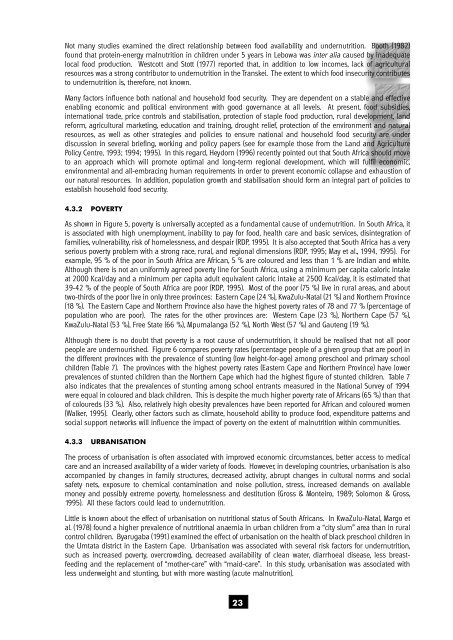the nutritional status of - Health Systems Trust
the nutritional status of - Health Systems Trust
the nutritional status of - Health Systems Trust
Create successful ePaper yourself
Turn your PDF publications into a flip-book with our unique Google optimized e-Paper software.
Not many studies examined <strong>the</strong> direct relationship between food availability and undernutrition. Booth (1982)<br />
found that protein-energy malnutrition in children under 5 years in Lebowa was inter alia caused by inadequate<br />
local food production. Westcott and Stott (1977) reported that, in addition to low incomes, lack <strong>of</strong> agricultural<br />
resources was a strong contributor to undernutrition in <strong>the</strong> Transkei. The extent to which food insecurity contributes<br />
to undernutrition is, <strong>the</strong>refore, not known.<br />
Many factors influence both national and household food security. They are dependent on a stable and effective<br />
enabling economic and political environment with good governance at all levels. At present, food subsidies,<br />
international trade, price controls and stabilisation, protection <strong>of</strong> staple food production, rural development, land<br />
reform, agricultural marketing, education and training, drought relief, protection <strong>of</strong> <strong>the</strong> environment and natural<br />
resources, as well as o<strong>the</strong>r strategies and policies to ensure national and household food security are under<br />
discussion in several briefing, working and policy papers (see for example those from <strong>the</strong> Land and Agriculture<br />
Policy Centre, 1993; 1994; 1995). In this regard, Heydorn (1996) recently pointed out that South Africa should move<br />
to an approach which will promote optimal and long-term regional development, which will fulfil economic,<br />
environmental and all-embracing human requirements in order to prevent economic collapse and exhaustion <strong>of</strong><br />
our natural resources. In addition, population growth and stabilisation should form an integral part <strong>of</strong> policies to<br />
establish household food security.<br />
4.3.2 POVERTY<br />
As shown in Figure 5, poverty is universally accepted as a fundamental cause <strong>of</strong> undernutrition. In South Africa, it<br />
is associated with high unemployment, inability to pay for food, health care and basic services, disintegration <strong>of</strong><br />
families, vulnerability, risk <strong>of</strong> homelessness, and despair (RDP, 1995). It is also accepted that South Africa has a very<br />
serious poverty problem with a strong race, rural, and regional dimensions (RDP, 1995; May et al., 1994, 1995). For<br />
example, 95 % <strong>of</strong> <strong>the</strong> poor in South Africa are African, 5 % are coloured and less than 1 % are Indian and white.<br />
Although <strong>the</strong>re is not an uniformly agreed poverty line for South Africa, using a minimum per capita caloric intake<br />
at 2000 Kcal/day and a minimum per capita adult equivalent caloric intake at 2500 Kcal/day, it is estimated that<br />
39-42 % <strong>of</strong> <strong>the</strong> people <strong>of</strong> South Africa are poor (RDP, 1995). Most <strong>of</strong> <strong>the</strong> poor (75 %) live in rural areas, and about<br />
two-thirds <strong>of</strong> <strong>the</strong> poor live in only three provinces: Eastern Cape (24 %), KwaZulu-Natal (21 %) and Nor<strong>the</strong>rn Province<br />
(18 %). The Eastern Cape and Nor<strong>the</strong>rn Province also have <strong>the</strong> highest poverty rates <strong>of</strong> 78 and 77 % (percentage <strong>of</strong><br />
population who are poor). The rates for <strong>the</strong> o<strong>the</strong>r provinces are: Western Cape (23 %), Nor<strong>the</strong>rn Cape (57 %),<br />
KwaZulu-Natal (53 %), Free State (66 %), Mpumalanga (52 %), North West (57 %) and Gauteng (19 %).<br />
Although <strong>the</strong>re is no doubt that poverty is a root cause <strong>of</strong> undernutrition, it should be realised that not all poor<br />
people are undernourished. Figure 6 compares poverty rates (percentage people <strong>of</strong> a given group that are poor) in<br />
<strong>the</strong> different provinces with <strong>the</strong> prevalence <strong>of</strong> stunting (low height-for-age) among preschool and primary school<br />
children (Table 7). The provinces with <strong>the</strong> highest poverty rates (Eastern Cape and Nor<strong>the</strong>rn Province) have lower<br />
prevalences <strong>of</strong> stunted children than <strong>the</strong> Nor<strong>the</strong>rn Cape which had <strong>the</strong> highest figure <strong>of</strong> stunted children. Table 7<br />
also indicates that <strong>the</strong> prevalences <strong>of</strong> stunting among school entrants measured in <strong>the</strong> National Survey <strong>of</strong> 1994<br />
were equal in coloured and black children. This is despite <strong>the</strong> much higher poverty rate <strong>of</strong> Africans (65 %) than that<br />
<strong>of</strong> coloureds (33 %). Also, relatively high obesity prevalences have been reported for African and coloured women<br />
(Walker, 1995). Clearly, o<strong>the</strong>r factors such as climate, household ability to produce food, expenditure patterns and<br />
social support networks will influence <strong>the</strong> impact <strong>of</strong> poverty on <strong>the</strong> extent <strong>of</strong> malnutrition within communities.<br />
4.3.3 URBANISATION<br />
The process <strong>of</strong> urbanisation is <strong>of</strong>ten associated with improved economic circumstances, better access to medical<br />
care and an increased availability <strong>of</strong> a wider variety <strong>of</strong> foods. However, in developing countries, urbanisation is also<br />
accompanied by changes in family structures, decreased activity, abrupt changes in cultural norms and social<br />
safety nets, exposure to chemical contamination and noise pollution, stress, increased demands on available<br />
money and possibly extreme poverty, homelessness and destitution (Gross & Monteiro, 1989; Solomon & Gross,<br />
1995). All <strong>the</strong>se factors could lead to undernutrition.<br />
Little is known about <strong>the</strong> effect <strong>of</strong> urbanisation on <strong>nutritional</strong> <strong>status</strong> <strong>of</strong> South Africans. In KwaZulu-Natal, Margo et<br />
al. (1978) found a higher prevalence <strong>of</strong> <strong>nutritional</strong> anaemia in urban children from a “city slum” area than in rural<br />
control children. Byarugaba (1991) examined <strong>the</strong> effect <strong>of</strong> urbanisation on <strong>the</strong> health <strong>of</strong> black preschool children in<br />
<strong>the</strong> Umtata district in <strong>the</strong> Eastern Cape. Urbanisation was associated with several risk factors for undernutrition,<br />
such as increased poverty, overcrowding, decreased availability <strong>of</strong> clean water, diarrhoeal disease, less breastfeeding<br />
and <strong>the</strong> replacement <strong>of</strong> “mo<strong>the</strong>r-care” with “maid-care”. In this study, urbanisation was associated with<br />
less underweight and stunting, but with more wasting (acute malnutrition).<br />
23
















